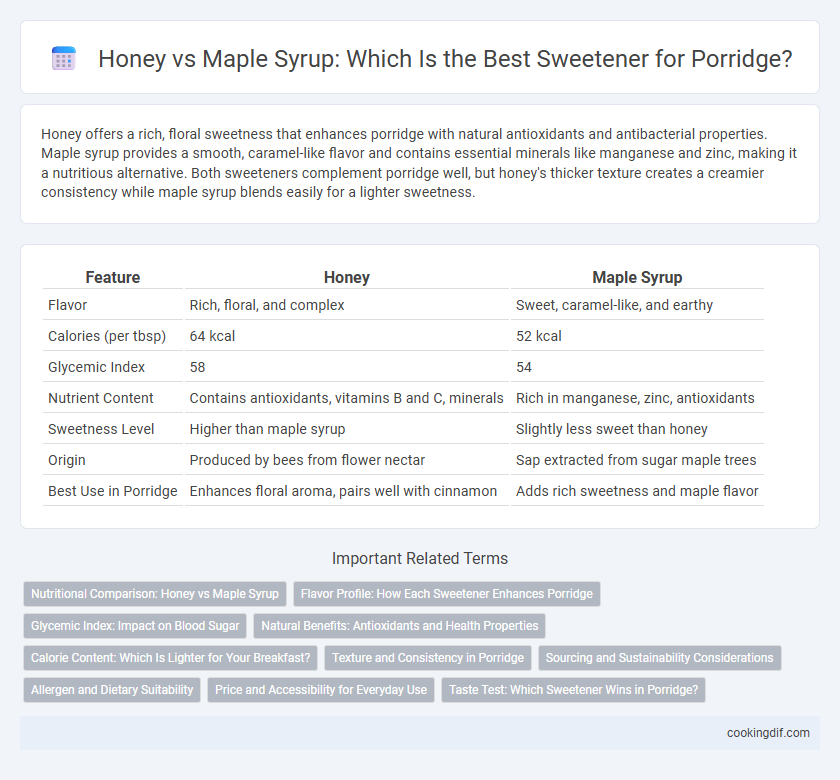Honey offers a rich, floral sweetness that enhances porridge with natural antioxidants and antibacterial properties. Maple syrup provides a smooth, caramel-like flavor and contains essential minerals like manganese and zinc, making it a nutritious alternative. Both sweeteners complement porridge well, but honey's thicker texture creates a creamier consistency while maple syrup blends easily for a lighter sweetness.
Table of Comparison
| Feature | Honey | Maple Syrup |
|---|---|---|
| Flavor | Rich, floral, and complex | Sweet, caramel-like, and earthy |
| Calories (per tbsp) | 64 kcal | 52 kcal |
| Glycemic Index | 58 | 54 |
| Nutrient Content | Contains antioxidants, vitamins B and C, minerals | Rich in manganese, zinc, antioxidants |
| Sweetness Level | Higher than maple syrup | Slightly less sweet than honey |
| Origin | Produced by bees from flower nectar | Sap extracted from sugar maple trees |
| Best Use in Porridge | Enhances floral aroma, pairs well with cinnamon | Adds rich sweetness and maple flavor |
Nutritional Comparison: Honey vs Maple Syrup
Honey contains higher levels of antioxidants and trace enzymes compared to maple syrup, offering additional health benefits beyond sweetness. Maple syrup is lower in calories and contains minerals such as manganese and zinc, which support immune function and metabolism. Both sweeteners have comparable glycemic indices, but honey has a higher fructose content that may affect blood sugar differently.
Flavor Profile: How Each Sweetener Enhances Porridge
Honey adds a rich, floral sweetness to porridge, complementing its creamy texture with subtle notes of wildflowers and caramel. Maple syrup delivers a robust, earthy flavor with hints of vanilla and cinnamon, enhancing porridge's warmth and depth. Both sweeteners elevate porridge uniquely, with honey providing a delicate complexity and maple syrup offering a bold, aromatic finish.
Glycemic Index: Impact on Blood Sugar
Honey has a glycemic index (GI) ranging from 45 to 64, causing a moderate increase in blood sugar levels when used as a porridge sweetener. Maple syrup's GI is typically lower, around 54, promoting a more gradual rise in blood glucose. Choosing maple syrup over honey can help maintain steadier blood sugar control during breakfast.
Natural Benefits: Antioxidants and Health Properties
Honey and maple syrup both offer natural antioxidants that enhance porridge's health benefits, with honey containing enzymes and phenolic compounds that support immune function and maple syrup rich in manganese and zinc, crucial for metabolism and antioxidant defense. Honey provides antibacterial properties and aids digestion due to its unique bioactive compounds, while maple syrup delivers polyphenols that reduce inflammation and oxidative stress. Choosing between the two depends on desired health effects, with honey favored for immune support and maple syrup for mineral content and anti-inflammatory benefits.
Calorie Content: Which Is Lighter for Your Breakfast?
Honey contains approximately 64 calories per tablespoon, while maple syrup has about 52 calories, making maple syrup the lighter option for sweetening porridge. Both natural sweeteners provide unique antioxidants and minerals, but choosing maple syrup can reduce breakfast calorie intake. Opting for maple syrup supports a slightly lower calorie diet without sacrificing flavor in your morning porridge.
Texture and Consistency in Porridge
Honey adds a thick, sticky texture to porridge, creating a rich and velvety consistency that blends smoothly with the oats. Maple syrup offers a thinner, more fluid texture, resulting in a lighter, more pourable porridge without altering the creaminess. Choosing honey enhances the porridge's density, while maple syrup maintains a delicate balance between sweetness and a smooth, easy-to-stir consistency.
Sourcing and Sustainability Considerations
Honey is typically sourced from local beekeepers, supporting sustainable pollination practices that benefit biodiversity, but it faces challenges related to bee population declines. Maple syrup is harvested from maple trees primarily in North America, relying on natural sap flow, which can be sustainable if managed with forest conservation practices. Both sweeteners have environmental impacts, yet maple syrup's reliance on forest ecosystems may offer a lower carbon footprint compared to commercial honey production.
Allergen and Dietary Suitability
Honey and maple syrup serve as popular natural sweeteners for porridge, yet they differ in allergen considerations and dietary suitability. Honey is unsuitable for infants under one year due to the risk of botulism and may trigger allergies in individuals sensitive to bee products. Maple syrup is generally allergen-friendly and vegan, making it a safer choice for those with dietary restrictions or plant-based diets.
Price and Accessibility for Everyday Use
Honey and maple syrup both serve as popular sweeteners for porridge, but honey generally offers better accessibility and lower price for everyday use. Retail prices for honey average around $4 to $6 per 12-ounce jar, while maple syrup typically costs $8 to $12 per pint, making honey a more budget-friendly option. Honey's widespread availability in supermarkets compared to the more niche market presence of maple syrup enhances its convenience for daily porridge preparation.
Taste Test: Which Sweetener Wins in Porridge?
Honey offers a rich, floral sweetness that blends smoothly with creamy porridge, enhancing its natural flavors without overpowering. Maple syrup provides a deeper, caramel-like taste with subtle woody undertones, creating a robust contrast that complements oats. Taste tests reveal that honey suits those preferring lighter, aromatic sweetness, while maple syrup appeals to fans of bold, complex flavors in porridge.
Honey vs Maple syrup for porridge sweetener Infographic

 cookingdif.com
cookingdif.com